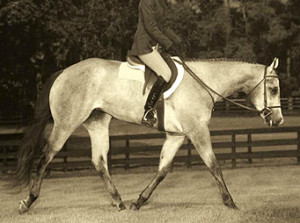Traditional vs. Trendy – Hunt Seat Fashion in 2018
Click here to read the complete article188 – January/February, 2018
 By Megan Arszman
By Megan Arszman
While watching the top Hunter under Saddle horse and riders circling the arena, can you picture these elegantly coiffed teams covering the rough terrain of the field, following a pack of Foxhounds? While it might seem like an odd image, that’s where the history of Hunter under Saddle, in terms of the horse’s movement and the rider’s attire, originated.
HISTORY OF HUNTER ATTIRE
According to AQHA Professional Horsewoman GiGi Bailey, the history of Hunt Seat comes from the sport of foxhunting. “Everything about Hunter under Saddle clothing attributes to foxhunting for a reason,” Bailey says.
Hunt Coats – Foxhunting typically takes place during the colder months of the year. At the start of the sport, there weren’t coats made of rayon or poly-blends. Jackets were made from wool, which kept the riders warm. The coats were mostly dyed in darker colors so riders didn’t stand out in the field. “It was part of being a little covert—as covert you can be while riding horses across a field with a bunch of Foxhounds chasing you!” she explains.
Shirts – Shirts for Foxhunting were longsleeved and had a traditional stock tie. Initially, the stock tie was white cotton, measuring four inches wide and about two feet long. The rider would wrap the tie around his/her neck a couple of times and then secure it with a large safety pin. This was to be used as a bandage if your horse cut his leg while on the hunt. “You didn’t ride over courses. You rode over people’s land, jumped over stone fences, and went through sticks and burrs,” Bailey says.
Boots and Breeches – Breeches were made of a thicker fabric than today’s version, but were tight fitting so as not to get caught on tree branches and brush. Tall leather boots protected a rider’s legs from the environment.
Accessories – Gloves were worn to keep hands warm in the chilly winter air. Jewelry was kept to a minimum. The saddle was minimally built so it wasn’t too heavy, but allowed the rider a sense of security without bulk. The reason why Hunt bridles have a noseband is so riders could tie up their horse when out in the field, if needed.
“Therefore, all of our tack and attire began for function,” Bailey explains.
Click here to read the complete article188 – January/February, 2018










